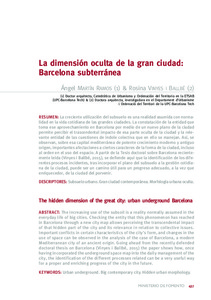Mostra el registre d'ítem simple
La dimensión oculta de la gran ciudad: Barcelona Subterránea
| dc.contributor.author | Martín Ramos, Ángel |
| dc.contributor.author | Vinyes Ballbé, Rosina |
| dc.contributor.other | Universitat Politècnica de Catalunya. Departament d'Urbanisme i Ordenació del Territori |
| dc.date.accessioned | 2017-10-24T16:53:11Z |
| dc.date.available | 2017-10-24T16:53:11Z |
| dc.date.issued | 2017-09 |
| dc.identifier.citation | Martin, A., Vinyes, R. La dimensión oculta de la gran ciudad: Barcelona Subterránea. "Ciudad y territorio, estudios territoriales", Setembre 2017, vol. XLIX, núm. 193, p. 437-452. |
| dc.identifier.issn | 1133-4762 |
| dc.identifier.uri | http://hdl.handle.net/2117/109076 |
| dc.description.abstract | La creciente utilización del subsuelo es una realidad asumida con normalidad en la vida cotidiana de las grandes ciudades. La constatación de la entidad que toma ese aprovechamiento en Barcelona por medio de un nuevo plano de la ciudad permite percibir el trascendental impacto de esa parte oculta de la ciudad y la relevante entidad de las cuestiones de índole colectiva que en ello se manejan. Así, se observan, sobre esa capital mediterránea de potente crecimiento moderno y antiguo origen, importantes afectaciones a ciertos caracteres de la forma de la ciudad, incluso al orden en el uso del espacio. A partir de la Tesis doctoral sobre Barcelona recientemente leída (Vinyes i Ballbé, 2015), se defiende aquí que la identificación de los diferentes procesos incidentes, tras incorporar el plano del subsuelo a la gestión cotidiana de la ciudad, puede ser un camino útil para un progreso adecuado, a la vez que enriquecedor, de la ciudad del porvenir. |
| dc.description.abstract | The increasing use of the subsoil is a reality normally assumed in the everyday life of big cities. Checking the entity that this phenomenon has reached in Barcelona through a new city map allows perceiving the transcendental impact of that hidden part of the city and its relevance in relation to collective issues. Important conflicts in certain characteristics of the city’s form, and changes in the use of space can be observed in the analysis of the case of Barcelona, a modern Mediterranean city of an ancient origin. Going ahead from the recently defended doctoral thesis on Barcelona (Vinyes i Ballbé, 2015) the paper shows how, once having incorporated the underground space map into the daily management of the city, the identification of the different processes related can be a very useful way for a proper and enriching progress of the city in the future. |
| dc.format.extent | 16 p. |
| dc.language.iso | spa |
| dc.subject | Àrees temàtiques de la UPC::Urbanisme |
| dc.subject.lcsh | City planning -- Spain -- Barcelona |
| dc.subject.lcsh | Underground architecture -- Spain -- Barcelona |
| dc.subject.other | Subsuelo urbano |
| dc.subject.other | Gran ciudad contemporánea |
| dc.subject.other | Morfología urbana oculta |
| dc.subject.other | Urban underground |
| dc.subject.other | Big contemporary city |
| dc.subject.other | Hidden urban morphology |
| dc.title | La dimensión oculta de la gran ciudad: Barcelona Subterránea |
| dc.type | Article |
| dc.subject.lemac | Urbanisme -- Catalunya -- Barcelona |
| dc.subject.lemac | Arquitectura subterrània -- Catalunya -- Barcelona |
| dc.contributor.group | Universitat Politècnica de Catalunya. GRU - Grup de Recerca Urbanisme |
| dc.description.peerreviewed | Peer Reviewed |
| dc.relation.publisherversion | https://www.fomento.gob.es/MFOM/LANG_CASTELLANO/DIRECCIONES_GENERALES/ARQ_VIVIENDA/SUELO_Y_POLITICAS/ESTUDIOS/REVISTA/ |
| dc.rights.access | Open Access |
| local.identifier.drac | 21582153 |
| dc.description.version | Postprint (published version) |
| local.citation.author | Martin, A.; Vinyes, R. |
| local.citation.publicationName | Ciudad y territorio, estudios territoriales |
| local.citation.volume | XLIX |
| local.citation.number | 193 |
| local.citation.startingPage | 437 |
| local.citation.endingPage | 452 |
Fitxers d'aquest items
Aquest ítem apareix a les col·leccions següents
-
Articles de revista [400]
-
Articles de revista [184]



